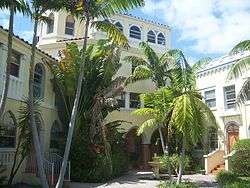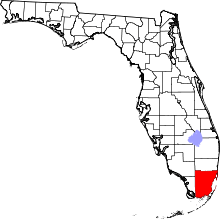Miami Shores, Florida
| Miami Shores, Florida | ||
|---|---|---|
| Village | ||
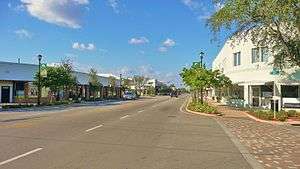 Downtown Miami Shores | ||
| ||
| Nickname(s): The Shores | ||
| Motto(s): Viventes In Sole | ||
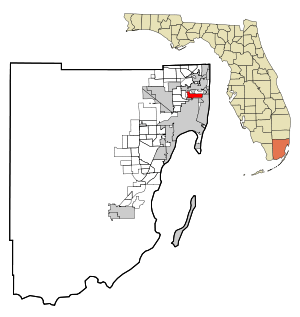 Location in Miami-Dade County and the state of Florida | ||
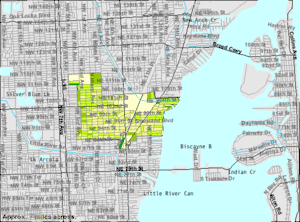 U.S. Census Bureau map showing village boundaries | ||
| Coordinates: 25°51′54.86″N 80°11′18″W / 25.8652389°N 80.18833°WCoordinates: 25°51′54.86″N 80°11′18″W / 25.8652389°N 80.18833°W | ||
| Country |
| |
| State |
| |
| County |
| |
| Incorporated | January 2, 1932 | |
| Government | ||
| • Type | Council-Manager | |
| • Mayor | Alice Burch (R) | |
| • Vice Mayor | Steven Zelkowitz (R) | |
| • Councilmembers |
Herta Holly (D) Jesse Walters (D) Ivonne Ledesma (D) | |
| • Village Manager | Tom Benton (R) | |
| • Village Clerk | Barbara A. Estep | |
| Area[1] | ||
| • Village | 3.78 sq mi (9.79 km2) | |
| • Land | 2.49 sq mi (6.44 km2) | |
| • Water | 1.29 sq mi (3.35 km2) 34.05% | |
| Elevation | 7 ft (2 m) | |
| Population (2010) | ||
| • Village | 10,493 | |
| • Estimate (2016)[2] | 10,762 | |
| • Density | 4,327.30/sq mi (1,670.91/km2) | |
| • Metro | 5,422,200 | |
| Time zone | UTC-5 (EST) | |
| • Summer (DST) | UTC-4 (EDT) | |
| Zip Codes | 33138, 33150, 33153, 33161, 33167, 33168 | |
| Area code(s) | 305, 786 | |
| FIPS code | 12-45175[3] | |
| GNIS feature ID | 0286760[4] | |
| Website | http://www.miamishoresvillage.com/ | |
Miami Shores is a village in Miami-Dade County, Florida, United States.
History
By the early 1900s, the area encompassing today's Miami Shores Village was occupied by a starch (coontie) mill, a tomato packing plant, a saw mill, a pineapple plantation and a grapefruit grove. These were the various enterprises in which the early pioneers were engaged and with the coming of the railroad and its stop at the Biscayne Station, they were able to live off the land. Two of the most successful growers were Major Hugh Gordon and T. V. Moore. T.V. Moore owned the land in what is today's commercial district, while the Gordon Tract bordered the bay. By 1922, Lee T. Cooper, who had amassed his wealth from a patent medicine by the name of Tanlac, purchased T.V. Moore's land holdings. Cooper planned to develop the area and named it Bay View Estates. In 1924, the Shoreland Company purchased the Gordon Tract, Bay View Estates and other scattered acreage in order to create Miami Shores, "America's Mediterranean."
Hugh M. Anderson, president of the Shoreland Company, and its board of directors were experienced real estate developers. They had previously completed the successful development of the Venetian Islands and they decided that their new project would be similar – residences of Italian inspired architecture within a landscape associated with water. The master development plan for Greater Miami Shores included 9,000 building sites, 5 2/3 miles of bay frontage, four miles of inland waterways and ten miles of main roadways. The plans also called for the construction of a causeway to Miami Beach, a golf course, a country club, a yacht club, a business district, apartment buildings, hotels, a school and churches, a railroad station and beautifying features such as parks, plazas and entryways.
Early in 1926, it was reported that approximately fifty homes had been completed, another fifty were under construction, and an additional one hundred were being planned. The commercial building program was in progress, sidewalks and roadways were being laid out and lighting and landscape work was well underway. Record setting sales and resales of property were being recorded. Unfortunately, on September 18, 1926, all plans for the community came to a halt with the arrival of a devastating hurricane. In addition, other factors contributed to the Shoreland Company's bankruptcy in 1927.
The present Miami Shores roughly corresponds with the original "Biscayne" neighborhood of the City of Miami. With the arrival of the Great Depression, the City of Miami gave up its jurisdiction and the area incorporated under the name Miami Shores Village in 1932. Previously, part of the area that now comprises the City of North Miami had been known as Miami Shores. Under the leadership of Roy H. Hawkins, a request to grant a charter creating Miami Shores Village was presented in the State Legislature. On January 2, 1932, the Village became official at a Council meeting. The charter named the following five members to the first council: Hugh H. Gordon, a banker whose father had owned the Gordon Tract; Frank O. Pruitt, who was in the insurance business; John M. Carlisle, President of the Eli Witt Cigar Company; W.F. Andes, a prominent dentist; and M.R. Harrison, a general contractor, who constructed much of Biscayne Boulevard. At this first meeting, Pruitt was elected Mayor and other appointments were made including Village Manager, Miller Williams; Village Attorney, George E. Holt; and a single policeman, Ed Badger.
In the decades that followed its incorporation, growth was steady. A variety of architectural styles were introduced, yet the community emerged as the type of development the Shoreland Company had envisioned. The community retains many of its original characteristics – well situated and serviced by major highways, having tree-lined streets and wide roads, a downtown area, well-maintained homes provided with efficient services and a variety of community activities.
Today, Miami Shores is primarily a bedroom community for those working in Greater Miami, and also has a sizeable retired population. The village is mostly single family residentialhomes, with very few multi-family units and only two small commercial areas along Northeast 2nd Avenue and Biscayne Boulevard.
While it is frequently referred to as "Miami Shores" or the "Village of Miami Shores," the municipality's official name under its charter is "Miami Shores Village."
Geography
Miami Shores is located at 25°51′55″N 80°11′18″W / 25.865240°N 80.188451°W.[5]
According to the United States Census Bureau, the village has a total area of 9.7 km2 (3.75 sq mi). 6.4 square kilometres (2.47 sq mi) of it is land and 3.3 square kilometres (1.3 sq mi) of it (34.05%) is water.
Demographics
| Historical population | |||
|---|---|---|---|
| Census | Pop. | %± | |
| 1930 | 612 | — | |
| 1940 | 1,956 | 219.6% | |
| 1950 | 5,086 | 160.0% | |
| 1960 | 8,865 | 74.3% | |
| 1970 | 9,425 | 6.3% | |
| 1980 | 9,244 | −1.9% | |
| 1990 | 10,084 | 9.1% | |
| 2000 | 10,380 | 2.9% | |
| 2010 | 10,493 | 1.1% | |
| Est. 2016 | 10,762 | [2] | 2.6% |
| U.S. Decennial Census[6] | |||
| Miami Shores Demographics | |||
|---|---|---|---|
| 2010 Census | Miami Shores | Miami-Dade County | Florida |
| Total population | 10,493 | 2,496,435 | 18,801,310 |
| Population, percent change, 2000 to 2010 | +1.1% | +10.8% | +17.6% |
| Population density | 4,191.9/sq mi | 1,315.5/sq mi | 350.6/sq mi |
| White or Caucasian (including White Hispanic) | 49.1% | 73.8% | 75.0% |
| (Non-Hispanic White or Caucasian) | 42.1% | 15.4% | 57.9% |
| Black or African-American | 23.8% | 18.9% | 16.0% |
| Hispanic or Latino (of any race) | 30.6% | 65.0% | 22.5% |
| Asian | 2.6% | 1.5% | 2.4% |
| Native American or Native Alaskan | 0.3% | 0.2% | 0.4% |
| Some Other Race | 2.3% | 3.2% | 3.6% |
As of 2012-2016, 40.2% of village residents spoke a language other than English at home, 49.2% possessed a bachelor's degree or higher, and the median household income was $101,047. About 6.5% of the population were below the poverty line.[7]
Based on 2010 data, the ancestries of only the Hispanic and Latino population from highest to lowest were as follows: Cubans made up 33.41%, South Americans were at 25.97%, Puerto Ricans accounted for 11.48%, Central Americans totaled 10.70%, and Mexicans were 2.95% of the Hispanic/Latino population.[8]
As of 2010, there were 3,935 households out of which 7.8% were vacant. In 2000, 32.1% had children under the age of 18 living with them, 51.0% were married couples living together, 12.1% had a female householder with no husband present, and 33.0% were non-families. 23.4% of all households were made up of individuals and 9.8% had someone living alone who was 65 years of age or older. The average household size was 2.67 and the average family size was 3.24. The village also has one of the highest percentages of homosexual couples in the United States.
In 2000, the village population was spread out with 22.5% under the age of 18, 12.1% from 18 to 24, 28.9% from 25 to 44, 24.0% from 45 to 64, and 12.6% who were 65 years of age or older. The median age was 38 years. For every 100 females, there were 95.1 males. For every 100 females age 18 and over, there were 91.7 males.
In 2000, the median income for a household in the village was $56,306, and the median income for a family was $64,963. Males had a median income of $42,373 versus $35,530 for females. The per capita income for the village was $26,134. About 6.9% of families and 8.8% of the population were below the poverty line, including 11.2% of those under age 18 and 7.6% of those age 65 or over.
As of 2000, Miami Shores had the 102nd highest percentage of Colombian residents in the US, with 1.64% of the US population.[9] It had the fifty-ninth highest percentage of Cuban residents in the US, at 6.27% of the village's population,[10] and the 121st highest percentage of Dominican residents in the US, at 1.28% of its population.[11] It also had the twentieth most Haitians in the US, at 8.30% of all residents.[12]
Government
Form of government
The village operates under a council-manager system. It has a Village Council of five members, who are elected at-large. The Village Charter provides that the two individuals receiving the highest number of votes are elected to four-year terms. The individual(s) receiving the next highest number of votes is elected to a two-year term. The position of Mayor is selected by the Council at its inaugural meeting. Historically, the individual receiving the highest number of votes is selected to serve as the Mayor and holds this position for two years of the four-year term. At the conclusion of their term as Mayor, the individual retains a seat on the Council as a "regular" Council member for the next two years. Elections are held every two years, with either two or three seats being open at each election in the ordinary course of events.
Each Council Member is a voting member of the Council, with the Mayor serving as the Chair. The council is responsible for enacting most village laws, approving capital expenditures, and hiring the Village Manager. There are also a number of administrative boards, such as Planning & Zoning, Code Enforcement, and Personnel Appeals, that manage various aspects of the Village government.
The Village Manager is the Village's chief executive officer, in charge of managing the day-to-day functions of the village. The village maintains its own police department, but fire services are supplied by the county, with Miami-Dade Fire Rescue Department Station No. 38 located in the village.
Regulation of vegetable gardens
In 2013, two residents, married couple Hermine Ricketts and Tom Carroll, were cited by the village under a code provision that prohibited vegetable gardens in front yards. The couple's entire front yard, along with the adjacent village-owned right of way, was planted with a large crop of various vegetables. They claimed that the garden had been in place for 17 years and supplied about 80% of their meals, eliminating their need to buy produce. The Miami Shores Code Enforcement Board ordered the couple to remove the garden or face a fine of $50 a day.
The Institute for Justice filed a suit on their behalf, claiming that the "backyard only" rule was arbitrary and violated the couple's property rights under the Florida Constitution.[13][14] The story garnered national attention. On August 25, 2016, Judge Monica Gordo granted the Village's summary judgment motion, finding that, "the prohibition of vegetable gardens except in backyards is rationally related to Miami Shores' legitimate interest in promoting and maintaining aesthetics," and that the rule, therefore, "passes constitutional scrutiny."
The ruling was subsequently upheld by the Florida Third District Court of Appeal, which stated, "Following the ineluctable conclusion that the Village ordinance does not restrict a fundamental right or suspect class, [two cases previously discussed] control the analysis in this case. The ordinance is constitutional. We agree with the trial court's parting observation that the appellants 'still have a remedy. They can petition the Village Council to change the ordinance. They can also support candidates for Council who agree with their view that the ordinance should be repealed.'"
Alleged racial discrimination in seatbelt ticketing
Following the January 2016 report, "Racial Disparities in Florida Safety Belt Law Enforcement," published by the ACLU (which did not mention Miami Shores), local CBS-affiliate station WFOR-TV gathered additional statistics from the Florida Department of Highway Safety and Motor Vehicles. A single sentence in WFOR's report noted that Miami Shores Police wrote 261 seat belt citations in 2014, with 186 (or 71%) of those citations going to African American drivers.[15]
The WFOR story did not, however, discuss the demographics of the area. African Americans resident make up a substantial minority of the 10,000 people who live in Miami Shores - 23.8%, as compared to 18.9% for Miami-Dade County and 16.31% for the State of Florida as a whole. More significantly, many of the neighborhoods surrounding Miami Shores have large African American majorities:North Miami, 58.9% African American; Little Haiti, 64.9% African American; West Little River, 57.2% African American; Gladeview, 76.98% African American; and Westview 75.6% African American. These communities are also significantly larger than Miami Shores. Each of these surrounding communities has a population equal to, or greater than, that of Miami Shores. The African American population of, for example, the City of North Miami, is more than three times the total population of Miami Shores. Given this large African American majority and the fact that major thoroughfares such as Biscayne Boulevard and Miami Avenue pass through Miami Shores, it is conceivable that a majority of people driving through Miami Shores at any given time are African American.
Educational institutions
Miami-Dade County Public Schools operates district public schools serving Miami Shores:
MDCPS schools[16]
- Miami Shores Elementary School
- Horace Mann Middle School
- Miami Edison High School
The following public, charter, and private schools are located in Miami Shores:
- Miami Shores Elementary School
- Doctors Charter School of Miami Shores at Barry University
- Miami Country Day School
- Miami Shores Presbyterian Church School
- Miami Shores Baptist Church Academy
- Miami Shores Community School
- St. Rose of Lima Catholic School
Colleges and universities
- Barry University's main campus is located in Miami Shores.
Public library
Brockway Memorial Library was founded in 1949.[17] While over the years the countywide Miami-Dade Public Library System has taken over the libraries of most of the cities in the county, the Miami Shores public library has remained independent. This independent public library first opened in February 1949 due to the generosity of George A. Brockway, an industrialist and part-time South Florida resident, who donated the funds to build the library. The land the library was built on was donated by Bessemer Properties under the management of Roy H. Hawkins. This library is considered the central cultural and educational hub of the Village of Miami Shores. Brockway Memorial Library offers patrons a large and diverse collection of materials that contain, print books, magazines, newspapers, online databases, eBooks, multimedia resources such as computers, DVDs, music and a diversity of social clubs and activities to serve the patrons and the community at large.[18] In 2002 funds were raised to be able to add 2500 square feet to the library. "This new addition was a multimedia room housing, electronic books, dedicated spaces for videos and audio books, reference materials, a Computer Center and the Miami Shores Archives." The Miami Shores Archives is a special collection of local area history. The library's schedule is available online.[19]
See also
Gallery
References
- ↑ "2016 U.S. Gazetteer Files". United States Census Bureau. Retrieved Jul 7, 2017.
- 1 2 "Population and Housing Unit Estimates". Retrieved June 9, 2017.
- ↑ "American FactFinder". United States Census Bureau. Retrieved 2008-01-31.
- ↑ "US Board on Geographic Names". United States Geological Survey. 2007-10-25. Retrieved 2008-01-31.
- ↑ "US Gazetteer files: 2010, 2000, and 1990". United States Census Bureau. 2011-02-12. Retrieved 2011-04-23.
- ↑ "Census of Population and Housing". Census.gov. Retrieved June 4, 2015.
- ↑ "US Census". Retrieved March 31, 2018.
- ↑ "Florida City, FL Population and Races". usatoday.com. Retrieved 2015-01-16.
- ↑ "Ancestry Map of Colombian Communities". Epodunk.com. Retrieved 2007-10-29.
- ↑ "Ancestry Map of Cuban Communities". Epodunk.com. Retrieved 2007-10-29.
- ↑ "Ancestry Map of Dominican Communities". Epodunk.com. Retrieved 2007-10-29.
- ↑ "Ancestry Map of Haitian Communities". Epodunk.com. Retrieved 2007-10-29.
- ↑ Life, liberty and the pursuit of vegetables, Miami Herald, Nov. 19, 2013.
- ↑ Miami Shores Sues Village Over Veggies, CBS Miami, Nov. 19, 2013.
- ↑ ACLU: Blacks Ticketed For Seat Belts Twice Rate Of Whites In Florida CBS4 January 26, 2016
- ↑ "Resident Information Mar 2016.pdf New Resident Information Brochure." Village of Miami Shores. p. 2/4. Retrieved on June 27, 2016.
- ↑ "The Brockway Library Story". Miamishoresvillage.com. Retrieved 2016-03-21.
- ↑ "The Brockway Library Story". Miamishoresvillage.com. Retrieved 2016-03-21.
- ↑ Christensen, Karen; Levinson, David (eds.). Heart of the community: Libraries We Love. Berkshire Publishing Group. pp. 50–51.
| Wikimedia Commons has media related to National Register of Historic Places in Miami Shores, Florida. |



